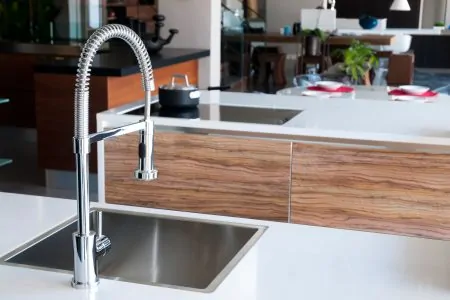Kitchen faucets are expensive, with some costing hundreds of dollars, so when yours breaks, it can sometimes be more economical to replace the part rather than the entire faucet. But how do you identify what brand of faucet you have?
We show you how to identify the kitchen faucet brand by the logo and where to locate the serial numbers.
Key Takeaways
- Check for logos or serial numbers on the faucet stem, base, or under the sink to identify the brand.
- Count the splines on the faucet stem’s broach, as each manufacturer has a specific number of splines, helping identify the brand.
- Examine the distinctive shapes and features of the faucet, such as the D-shaped broach in Delta faucets or T and S faucets’ bulge at the base of the stem.
- Use a broach gauge, Google Lens app, or compare your faucet to those in a large DIY store to help identify the brand.
How To Identify a Kitchen Faucet Brand
Knowing what brand of faucet you have is crucial if you want to replace broken components when they fail. Some brands are easy to spot, while others take a little bit of investigation. Here’s how to do it.
Logo
There are several ways to find the logo on your kitchen faucet, some of them less obvious than others. You could try cleaning the faucet to reveal the logo if it is hidden under a layer of grime and soap scum. Try looking at the base of the stem for etched logos that are notoriously challenging to see.
Feel around the shaft of the tap or shine a flashlight to illuminate any etched writing. Another easy way is to read the manual, although not everyone keeps hold of them.
Model Number
When you cannot find the logo, you could always try and locate the serial number. As with looking for the branding, give the tap a clean with soap and water to reveal any signs of a serial number.
It’s also worth crawling under the sink with the flashlight and checking that the serial number is underneath. Often the least obvious places are the best areas to start looking.
The flashlight technique comes in handy too because it illuminates the small etched numbers. Focus your search on the escutcheon, the shaft, and the spout. Once you find the serial number, you can enter it into a search engine to locate the brand.
Broach and Splines
The broach is a component of the top of the stem that fits into the bottom of the handle. The splines are the grooves cut into the broach, and they are like a fingerprint to identify each manufacturer because the number of splines varies between companies.
To get to the broach, you will need to remove the decorative cap to unscrew the handle from the sink. Grab a marker pen and mark the first spline as a start point and start counting. When you arrive back at your marked one, you know you have included all of them.
You can also identify the maker by the length of the stem. Here’s a handy chart to help you:
| Distinguishing Features | Manufacturer |
| 4-Point square broach | Milwaukee, Royal Brass, Speakman, Sterling, American standard, Chicago, Concinnity, Gerber, Price Pfister, Symmons, Zurn |
| 8-Point broach | Briggs |
| 12-Point, 0.335-inch broach | Crane Dial Eze, Michigan Brass, Wolverine |
| 12-Point, 0.375-inch broach | Arrowhead, Artistic Brass, Harcraft, Glauber, Price Pfister, Scoville, Universal Brass |
| 12-Point, 0.39-inch broach | Bradley, Elkay, Fisher, Sears, Universal Rundle |
| 12-Point, 0.415-inch broach | Symmons |
| 12-Point, 0.485-inch broach | Crane, Symmons |
| 15-Point broach | Santec, Savoy, Wolverine |
| 16-Point, 0.360 broach | Gerber, Sayco |
| 16-Point, 0.370-inch broach | Acme, American Standard Cadet & Colony, Barnes, Burlington, Central Brass, Concinnity, Eljer, Glauber, Harden, Kohler Trand, Milwaukee, Newport, Phylrich, Royal Brass, Scoville |
| 16-Point, 0.40-inch broach | Sterling |
| 17-Point broach | American Brass, Mansfield, Midcor, Phoenix, Streamway |
| 18-Point broach | Briggs, Indiana Brass, Union Brass |
| 20-Point, 0.285-inch broach | Broadway, Concinnity, Danfoss, Dornbracht, Eljer, Grohe, Jado, Kohler, Milwaukee, Paul |
| 20-Point, 0.415-inch broach | Broadway, Speakman, T & S Brass |
| 22-Point, 0.375-inch broach | American Standard old 3/8″ |
| 22-Point, 0.438-inch broach | American Standard current 7/16″ |
| 38-Point broach | Import, Pegasus, Glacier Bay |
Shape and Size
Another way to tell what brand of faucet you have is to look for distinctive shapes and features. Delta faucets have a d-shaped broach, which makes them easy to identify. This differs from Moen, which has an oval-shaped faucet.
T and S make their faucets with a distinctive bulge at the base of the stem where it meets the handle.
Use a Broach Gauge
This is a favorite method of professionals because it is quick and easy to do. A broach gauge comes with a key that makes the size of your broach instantly recognizable. Simply insert the faucet stem into the female ends or the faucet handle into the male end of the gauge until you get a match.
Using Google Lens
If you have the Google lens app on your smartphone, you could try scanning the faucet and seeing if it can identify it using technology. It might work, but it shouldn’t be relied upon as it is not always accurate.
Gauge Like for Like
If all else fails and you are still in the dark about the manufacturer, you could always remove the faucet and take it to a large DIY store where they have an extensive collection of taps. You might get an exact match or spot key features in particular models that look similar to yours.
This isn’t an exact science, but it might give you something to go on when doing your research.
Where There’s a Will, There’s a Way
By conducting extensive research and following all of the tips above, you should identify your brand of faucet from the extensive range available. It might not be easy, but you should succeed.
Failing that, it might be worth checking if any of the brands share similar components and maybe think about swapping parts to get that repair done.






